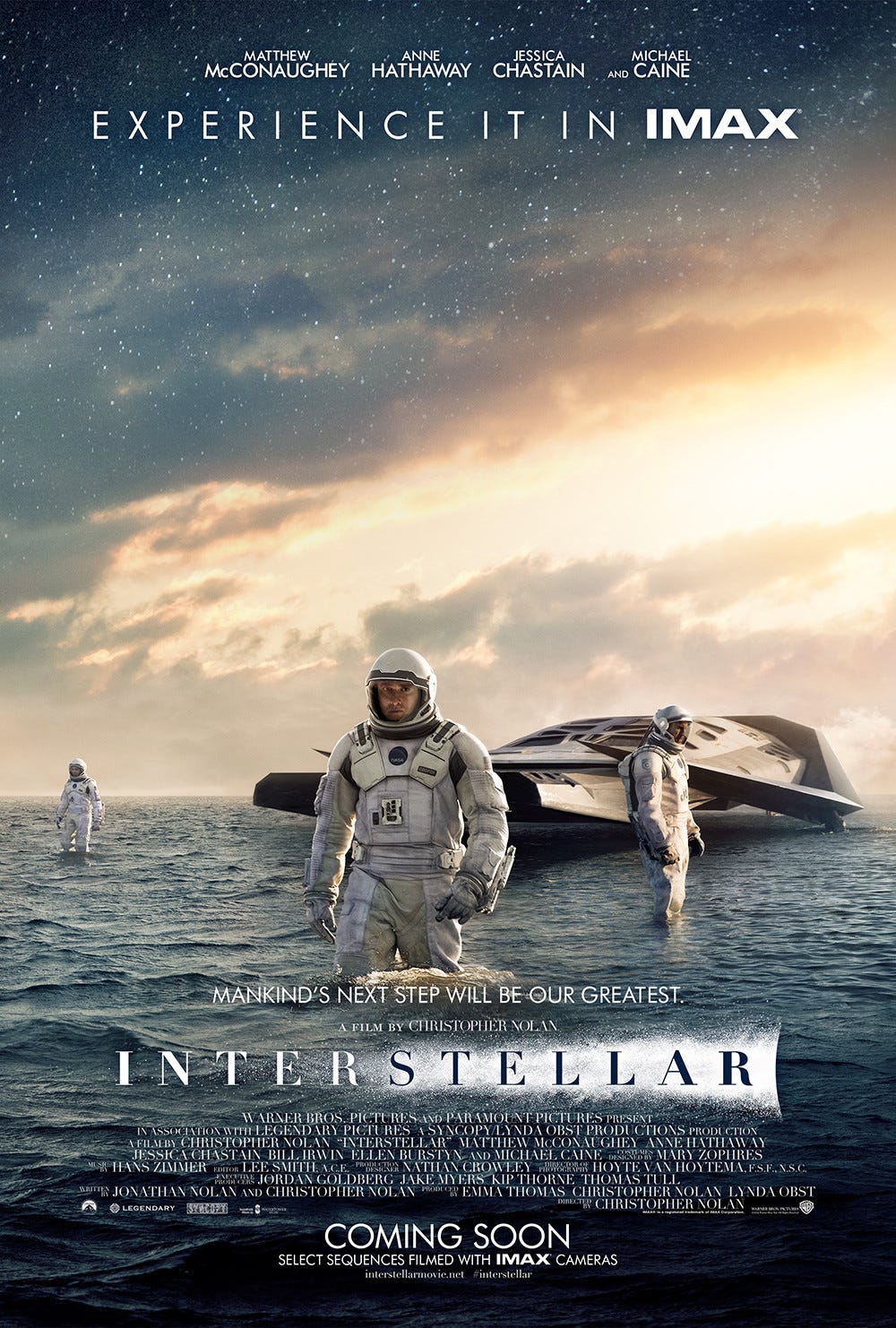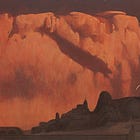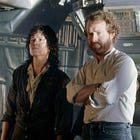Interstellar: Beyond the Stars, Into the Soul
"Interstellar" pushed the boundaries of what science fiction cinema could be, offering not just a thrilling adventure but a contemplative exploration of human existence.
Released in 2014, "Interstellar" is often regarded as one of the most ambitious science fiction films of the 21st century. Directed by Christopher Nolan, the film blends scientific accuracy with an emotionally charged narrative, leaving a lasting impact on both audiences and the scientific community. Grossing over $677 million worldwide, it quickly became a cultural phenomenon that sparked conversations about the future of humanity, the nature of time, and the vast possibilities of space exploration.
Christopher Nolan: The Visionary Director
Christopher Nolan, known for his complex narratives and innovative filmmaking techniques, approached "Interstellar" with a vision to make a space epic grounded in real science. Unlike many sci-fi films that take creative liberties, Nolan insisted on working closely with renowned physicist Kip Thorne to ensure that the film's portrayal of black holes, wormholes, and time dilation was as accurate as possible. This collaboration led to some groundbreaking visual effects, particularly in the depiction of the black hole, Gargantua.
Interestingly, the film's visual representation of the black hole required the rendering of over 800 terabytes of data, creating an image so complex that it provided new insights into gravitational lensing. This dedication to scientific authenticity was not just for show—Nolan wanted audiences to experience the awe and terror of space in a way that felt real. This pursuit of accuracy even extended to the sound design, where Nolan used actual recordings from NASA missions to create an immersive auditory experience.
The Music of Interstellar: Hans Zimmer's Masterpiece
Hans Zimmer's score for "Interstellar" is often cited as one of the most memorable aspects of the film. Nolan took a unique approach when commissioning Zimmer for the project. Instead of providing a detailed script or synopsis, Nolan handed Zimmer a single page of story notes that focused on the relationship between a father and his child. Zimmer composed the initial pieces of music without knowing the film's broader scope, resulting in a deeply emotional and personal score that transcended typical sci-fi soundtracks.
The decision to use the 1926 four-manual Harrison & Harrison organ at London's Temple Church added a profound and almost spiritual dimension to the music. This choice was intentional, as Nolan and Zimmer aimed to evoke a sense of grandeur and the infinite. The score was recorded in such a way that it mirrored the film's narrative arc, with moments of intense quiet interspersed with overwhelming crescendos. In post-production, Nolan even adjusted the pacing of several key scenes to align with Zimmer's music, a testament to the score's integral role in the film's storytelling.
The Cast: Stellar Performances
"Interstellar" boasts a remarkable cast, headlined by Matthew McConaughey, Anne Hathaway, Jessica Chastain, and Michael Caine. McConaughey's portrayal of Cooper, a pilot and engineer turned reluctant astronaut, brought a grounded, everyman quality to the role. His performance was lauded for its emotional depth, particularly in scenes where he grapples with the pain of leaving his children behind to save humanity.
Anne Hathaway's role as Dr. Amelia Brand added a different dynamic to the film, representing the conflict between scientific reasoning and the human element of love. Hathaway underwent rigorous preparation for the role, including immersing herself in the theoretical physics behind her character's motivations. In one particularly grueling scene shot in Iceland, Hathaway ended up with hypothermia after multiple takes in freezing water, highlighting the physical demands placed on the actors to bring authenticity to their performances.
Jessica Chastain's portrayal of the adult Murph, Cooper's daughter, served as the emotional anchor for the film. Her scenes on Earth provided a stark contrast to the cosmic journey of the main storyline, grounding the narrative in the human experience of time passing and the pain of separation. Chastain's ability to convey complex emotions with minimal dialogue made her performance one of the film's standout elements.
The Film Itself: A Milestone in Science Fiction Cinema
"Interstellar" is more than just a visual spectacle; it's a film that tackles profound themes such as survival, love, sacrifice, and the quest for knowledge. The narrative is centered around humanity's struggle to find a new home as Earth becomes increasingly uninhabitable. This premise allowed Nolan to explore the human condition under extreme circumstances, drawing on themes of desperation, hope, and the innate desire to connect with others, even across the vastness of space.
The film's scientific grounding is one of its most impressive aspects. Thorne's involvement ensured that elements like the wormhole near Saturn and the time dilation experienced on Miller's planet were portrayed with an unprecedented level of accuracy. This meticulous attention to detail not only made for a visually stunning film but also educated audiences on complex scientific concepts. For instance, the depiction of the black hole, Gargantua, was so accurate that it helped astrophysicists gain new insights into how black holes affect light.
Another fascinating fact is that Nolan initially wanted the film to be directed by Steven Spielberg, who was attached to the project in its early development stages. When Nolan took over, he reworked the script, infusing it with his signature themes of time, memory, and human resilience. The cornfield scenes, particularly the iconic chase sequence, involved the planting of 500 acres of corn specifically for the film, which was later sold and contributed to the film's budget—a practical and innovative approach to set design.
Inspirations from the Cosmos: Films That Paved the Way for Interstellar
Before "Interstellar" took audiences on its epic journey through space and time, there were several groundbreaking films that inspired its creation. Christopher Nolan drew on a rich tradition of science fiction cinema, paying homage to classic movies while crafting a narrative uniquely his own. These films not only laid the groundwork for the visual and thematic elements in "Interstellar" but also helped shape the way audiences perceive space exploration and the human experience within it.
2001: A Space Odyssey (1968)
Stanley Kubrick's "2001: A Space Odyssey" is perhaps the most significant influence on "Interstellar." Widely regarded as a masterpiece of science fiction, "2001" set the standard for how space travel could be portrayed on screen. Kubrick's meticulous attention to detail, use of practical effects, and the film's meditative pacing were revolutionary for its time. The film’s enigmatic narrative, combined with its groundbreaking visual effects, offered a portrayal of space that was both awe-inspiring and terrifying.
Nolan has often cited "2001" as a major inspiration, particularly in its ability to convey the vastness and silence of space. In "Interstellar," the docking sequences, the use of silence during space scenes, and the existential questions posed by the film echo Kubrick’s influence. Nolan wanted to capture a similar sense of wonder and philosophical depth, blending it with a more emotional core centered on the human experience. The design of the TARS and CASE robots in "Interstellar" also pays homage to "2001’s" HAL 9000, though Nolan’s robots possess a more humanistic and collaborative role rather than a menacing one.
Close Encounters of the Third Kind (1977)
Steven Spielberg's "Close Encounters of the Third Kind" is another film that significantly impacted Nolan's approach to "Interstellar." Spielberg’s film is known for its portrayal of an ordinary man's obsession with extraterrestrial life and the emotional depth it brings to the science fiction genre. "Close Encounters" humanized the idea of contact with the unknown, focusing on personal connections and the psychological impact of encountering something beyond our understanding.
Nolan incorporated a similar emotional journey in "Interstellar," particularly through the character of Cooper. The film's focus on the bond between Cooper and his daughter, Murph, mirrors the emotional core of "Close Encounters." Both films explore themes of communication and the lengths humans will go to for understanding and connection, whether it’s with alien life or with loved ones across the boundaries of space and time.
Solaris (1972)
Andrei Tarkovsky’s "Solaris" is another seminal work in science fiction that explores the inner landscapes of the human mind as much as it does the outer reaches of space. The film delves into themes of memory, grief, and the nature of human consciousness, using a mysterious alien planet that brings a man's deepest emotions and regrets to life. Tarkovsky’s philosophical approach to the genre challenged the notion that science fiction had to be about technology and action, instead suggesting it could be a vehicle for exploring the human soul.
"Interstellar" draws from "Solaris" in its introspective and emotional approach to space travel. The concept of a journey not just outward, but inward, is central to both films. The "tesseract" scene in "Interstellar," where Cooper navigates his daughter's bookshelf from within a black hole, resonates with Tarkovsky's portrayal of space as a mirror to human consciousness. The idea that space exploration can lead to profound self-discovery and an encounter with our deepest fears and desires is a theme that both films share.
The Right Stuff (1983)
"The Right Stuff," directed by Philip Kaufman, is a historical drama that chronicles the early days of the U.S. space program and the test pilots who became the first astronauts. The film’s realistic portrayal of the bravery, camaraderie, and sacrifices involved in pioneering space travel had a significant impact on "Interstellar." Nolan admired how "The Right Stuff" depicted the human side of space exploration, focusing on the individuals who risk everything to push the boundaries of what’s possible.
In "Interstellar," this human element is brought to life through the characters’ sacrifices and the dangers they face in their mission. The film doesn't shy away from the physical and emotional toll of space travel, much like "The Right Stuff." The attention to detail in the depiction of spaceflight, from the launch sequences to the zero-gravity effects, echoes the authenticity and respect for the astronauts that "The Right Stuff" embodied.
Contact (1997)
Based on Carl Sagan’s novel, "Contact" directed by Robert Zemeckis, is a film that Nolan has openly acknowledged as an influence on "Interstellar." "Contact" tells the story of an astronomer, played by Jodie Foster, who discovers a signal from an alien civilization and becomes part of humanity’s first attempt to make contact with extraterrestrial intelligence. The film explores the intersection of science, faith, and the quest for knowledge.
Like "Contact," "Interstellar" deals with the theme of communication across vast distances and the idea that there are forces and dimensions beyond our current understanding. The use of wormholes as a means of traversing the universe is a concept that both films explore, though in different contexts. Additionally, the emotional journey of a protagonist willing to venture into the unknown for the sake of discovery is a central theme in both films.
Why Interstellar Changed Our Lives
"Interstellar" had a significant impact beyond its cinematic achievements. It reignited public interest in space exploration and sparked debates on topics such as the potential for human colonization of other planets and the ethical implications of leaving Earth behind. The film's exploration of time dilation, love as a unifying force, and the unknown possibilities of the universe challenged viewers to think deeply about their own lives and the legacy we leave for future generations.
Moreover, the film's influence extended into academia, with a noticeable increase in enrollment in physics and astronomy courses following its release. Kip Thorne's companion book, "The Science of Interstellar," became a bestseller, demonstrating the public's appetite for understanding the science behind the story. The film also inspired a generation of aspiring filmmakers and scientists to pursue their passions, blending art and science in a way that few films have achieved.
"Interstellar" pushed the boundaries of what science fiction cinema could be, offering not just a thrilling adventure but a contemplative exploration of human existence. It reminded us of our small yet significant place in the universe and the power of love and human connection to transcend even the most insurmountable barriers.









👏🏻💫